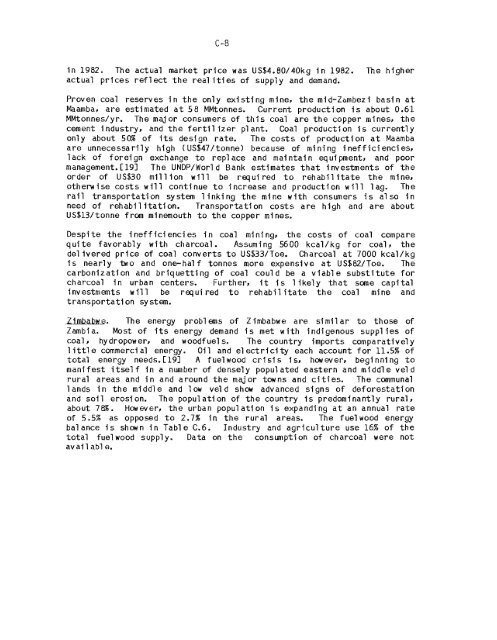Prospects for Coal Briquettes as a Substitute Fuel for Wood and ...
Prospects for Coal Briquettes as a Substitute Fuel for Wood and ...
Prospects for Coal Briquettes as a Substitute Fuel for Wood and ...
Create successful ePaper yourself
Turn your PDF publications into a flip-book with our unique Google optimized e-Paper software.
c-8<br />
in 1982, The actual market price w<strong>as</strong> US$4.80/40kg in 1982. The higher<br />
actual prices reflect the realities of supply <strong>and</strong> dem<strong>and</strong>.<br />
Proven coal reserves in the only existing mine, the mid-Zambezi b<strong>as</strong>in at<br />
hambar are estimated at 58 MMonnes. Current production is about 0.61<br />
MMtonnes/yr. The major consumers of this coal are the copper miness the<br />
cement industry, <strong>and</strong> the fertll izer pl ant. <strong>Coal</strong> production 1 s current1 y<br />
only about 50% of its deslgn rate. The costs of production at Mamba<br />
are unnecessarily high (US$47/tonne) because of mining inefficiencies,<br />
lack of <strong>for</strong>eign exchange to replace <strong>and</strong> maintain equipment, <strong>and</strong> poor<br />
management. C191 The UNDP/Worl d Bank estimates that investments of the<br />
order of US30 million w i l l be required to rehabilitate the mine,<br />
otherwise costs w i l l continue to incre<strong>as</strong>e <strong>and</strong> production w i l l lag. The<br />
rail transportatlan system linking the mine with consumers is also In<br />
need of rehabil itatlon. Transportation costs are high <strong>and</strong> are about<br />
US$13/tonne from minemouth to the copper mines.<br />
Despite the inefficiencies in coal minfng, the costs of coal compare<br />
quite favorably with charcoal. Assuming 5600 kcal/kg <strong>for</strong> coalP the<br />
delivered price of coal converts to US$33/Toe. Charcoal at 7000 kcal/kg<br />
is nearly two <strong>and</strong> one-half tonnes more expensive at USdWToe. The<br />
carbonization <strong>and</strong> Sriquetting of coal could be a viable substitute <strong>for</strong><br />
charcoal in urban centers. Furtherl it is likely that some capital<br />
investmmts w i l l be required to rehabilitate the coal mine <strong>and</strong><br />
transportation system.<br />
a The energy problems of Zimbabwe are similar to those of<br />
Most of its energy dem<strong>and</strong> is met with indigenous supplies of<br />
coal hydropower, <strong>and</strong> noodf uel s. The country imports comparatl<br />
little commercial energy, Oil <strong>and</strong> electricity each account <strong>for</strong> 11.<br />
total energy needs.Cl91 A fuelwood crlisis is8 hcwwer, beglnni<br />
manifest itsel f in a number of densely populated e<strong>as</strong>tern <strong>and</strong> middl e vel d<br />
rural are<strong>as</strong> <strong>and</strong> in <strong>and</strong> around the major towns <strong>and</strong> cities. The communal<br />
l<strong>and</strong>s in the middle <strong>and</strong> low veld show advanced signs of de<strong>for</strong>estation<br />
<strong>and</strong> soil erosion. The population of the country is predominantly rural,<br />
. However, the urban population is exp<strong>and</strong>ing at an annual rate<br />
<strong>as</strong> opposed to 2.7% in the rural are<strong>as</strong>. The fuelwood energy<br />
bal ance is sh n in Table (2.6. Industry <strong>and</strong> agriculture use 16% of the<br />
total fuelwood supply. Data on the consumption of charcoal were not<br />
av ai 1 ab1 e.

















